Welcome to our blog post on a month-by-month almond orchard management maintenance guide! This guide will provide valuable insights and tips to ensure maximum yield from your almond orchard throughout the year. Whether you’re a seasoned almond farmer or just starting, this comprehensive guide will assist you in understanding the essential tasks and best practices for each month.
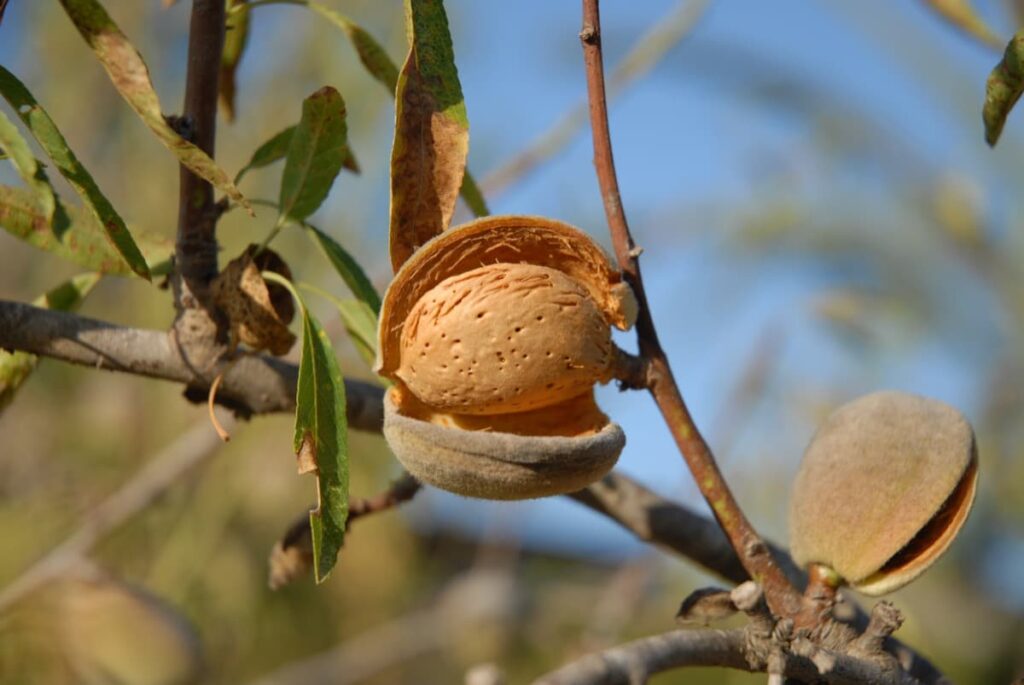
We’ll cover everything from pruning and irrigation to pest control and pollination. By following our practical advice, get ready to optimize your almond orchard’s productivity and achieve bountiful yields.
Almond Orchard Management
What is Almond Farming and its Overview?
Almond farming involves cultivating almond trees native to Iran and neighboring regions like the Levant. These trees produce almonds, which are edible and widely cultivated seeds. Almonds belong to the subgenus Amygdalus within the Prunus genus, alongside peaches. One distinctive feature is the corrugated shell that surrounds the almond seed.
Almonds are drupes consisting of an outer hull and a hard shell enclosing the seed. To obtain the edible part, the shell is removed through shelling. Almonds can be purchased either shelled or unshelled. Blanched almonds have been soaked in hot water to soften the seedcoat, allowing easy removal and revealing the white embryo. Once cleaned and processed, almonds can be stored for a long time. They are widely used in various cuisines, particularly in desserts like marzipan.
Almond trees thrive in moderate Mediterranean climates with cool winters. California contributes to more than half of the world’s almond production. However, the sustainability of almond cultivation in California has raised concerns due to its high water demand, large acreage, and reliance on pesticides. The ongoing droughts and increasing heat from climate change have intensified these challenges.
In case you missed it: Optimizing Litchi Orchard Management: A Month-by-Month Maintenance Guide for Maximum Yield
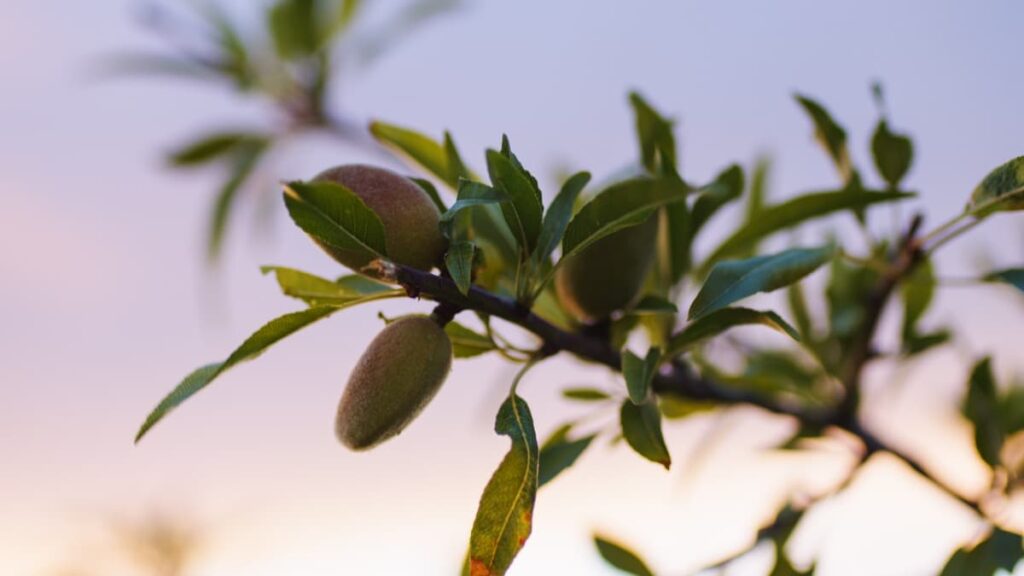
Description of Almond Orchard
Almond trees are deciduous trees that can grow from 4 to 12.2 meters (13 to 40 feet) tall with a trunk diameter of 25-35 centimeters (12 inches). Young twigs start green, turn purplish in the sunshine, and turn gray in their second year. The leaves are 8–13 centimeters (3–5 inches) long with a 2.5-centimeter (1-inch) petiole and serrated margins. Almond trees have gorgeous white to pale pink flowers that develop before the foliage in early spring.
Mediterranean regions with warm, dry summers and mild, damp winters suit almonds. They grow best at 15–30 degrees Celsius (59–86 degrees Fahrenheit), and the buds need 200–700 hours of freezing below 7.2 degrees Celsius (45.0 degrees Fahrenheit) to break dormancy. Almond trees start producing a major crop in their third year after planting and reach maximum output five to six years later.
After flowering, the drupe-like fruit matures in October. The almond fruit is 3.5–6 cm long. The thick, leathery hull is gray-green. The pyrena, a peach pit-like woody shell, is inside the hull. The nut-like seed is inside the shell. Some seeds have two. When the fruit matures, the hull splits from the shell, and an abscission layer forms between the stem and the fruit, allowing it to fall off the tree.
Best Tips for Growing Almond Orchard Maintenance Practices
Almond cultivation is widely practiced in various parts of the world, especially in Asia’s southern and middle eastern regions. California almonds are renowned globally, while in India, almond farming is predominantly carried out in the colder hilly zones such as Jammu & Kashmir, Himachal Pradesh, Uttarakhand, Kerala, and certain hilly areas of Andhra Pradesh.
Like peaches, apricots, and plums, almond trees resemble other fruit trees. Almonds can be enjoyed as a dry fruit or nut and are used to prepare delectable sweet dishes. They are also consumed with milk. Almond farming is gaining popularity and achieving remarkable success in most Asian countries, primarily due to its nutritional value.
Varieties of Almonds
- Dry Temperature Region Varieties: Ni Plus Ultra, Texas, and Threshold.
- High and Middle Mountainous Region Varieties: Nikitskai, Non-Peril, ISL, Merced, and White Brandis.
Required Climatic Conditions for Almond Farming
Almond farming thrives in colder regions with temperatures ranging from 7°C to 24°C. The ideal altitude for almond plant growth is between 750 to 3200 meters above sea level, with an average rainfall requirement of 75 to 110 cm.
In case you missed it: Optimizing Avocado Orchard Management: A Month-by-Month Maintenance Guide for Maximum Yield
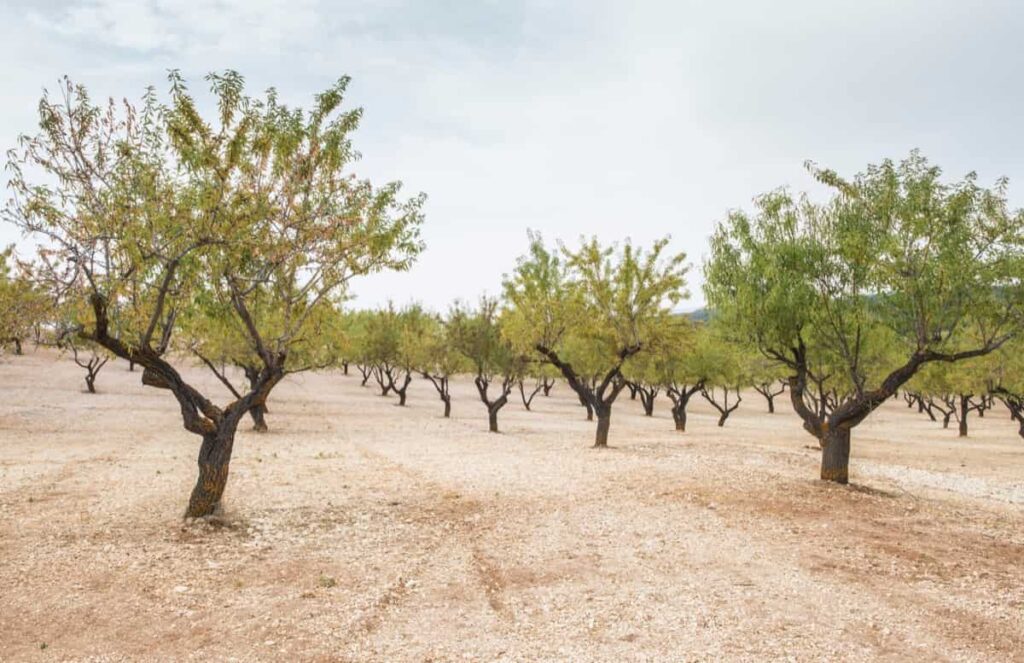
Soil for Almond Cultivation
Flat, loamy, and deep fertile soil is most suitable for almond cultivation. Additionally, ensuring proper drainage is crucial for the health and productivity of almond plants.
Planting Techniques for Almonds
Almonds are typically grown using Biju and Grafting techniques. The seeds of almonds, peaches, and plums are commonly used as grafting stalks for almond plant propagation. When transplanting, using almond seeds or one-year-old plants with healthy and leafless roots is important.
Before transplantation, prepare pits in the field and add cow dung and earthworm manure. The best time for planting is between November and December. The recommended pit size is 111 meters, with a spacing of approximately 6 meters between plants and 7 meters between rows. To ensure proper pollination, having 5-7 cans of bees per hectare of land is advisable.
Irrigation and Water Requirement
During winter, irrigation should be carried out at 20-30 days intervals. Regular irrigation at 10-day intervals in summer is necessary for fruit-bearing plants to prevent premature fruit drop. Additionally, organic materials such as straw or leaves can be used as mulch around almond trees to control weed growth.
Weeding
Regular weeding is essential for optimal almond yields. The first weeding should be done within 10-15 days after planting to promote healthy plant growth. Subsequent weeding should be performed regularly.
Almond Fruit Harvesting
Almond trees typically bear fruit from the third year after transplantation, with increased yields after 6-7 years. Almonds are ready for harvesting approximately eight months after flowering when the pods’ peel transitions from green to yellow. Harvesting can be done using poles to aid in the collection of almonds. After harvesting, it is important to sun-dry the almond nuts or use forced hot air drying methods until the moisture content reaches 5 to 7% to prevent fungal infections.
Yield
On average, almond orchards can yield 1-2 tonnes per hectare.
Almond Post Harvesting
After almond harvesting, the almonds undergo two processing phases: post-harvest processing and finish processing. These phases are typically carried out at separate facilities. Post-harvest processing includes hulling and separating operations, common to both facilities producing in-shell almonds or shelled almond meats.
Additional steps are taken in huller/sheller facilities to remove the almond meats from their shells. The hulled almonds are then transported to large production facilities for further processing into various end products. Almond harvesting and processing are seasonal, starting in August and lasting two to four months, depending on weather conditions and crop size.
In case you missed it: Mastering the Dragon Fruit Orchard Management: A Month-by-Month Operations Guide for Maximum Yield
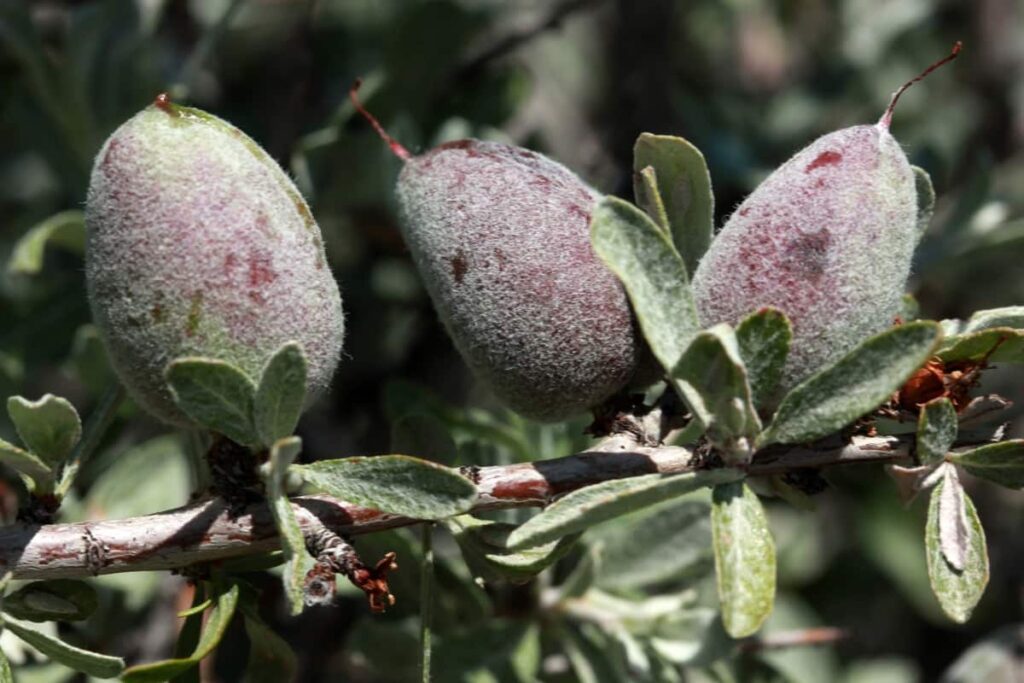
Almonds are harvested manually or mechanically and are left to dry on the ground for 7 to 10 days before being gathered and transported to the processing facility. The gathered almonds contain debris such as leaves, grass, twigs, pebbles, and soil, which are removed through screens and equipment. The debris is disposed of or used as fuel, while the precleaned almonds are stored in bins for further processing.
January Month Almond Orchard Maintenance Planning
During January month for almond orchard maintenance planning, it is important to take certain steps. If flowers continue to appear on grafted plants, they should be removed by pinching to redirect the plant’s energy toward growth rather than flowering. A second spray with Endo sulphon at a rate of 2ml per liter should be applied. It is essential to water the plants regularly, maintaining a 5-day interval between watering sessions.
February Month Almond Orchard Maintenance Planning
Regular watering should be done in February at a 5-day interval to ensure adequate plant hydration. Keep a close eye on each plant for the appearance of bark borers and stem borers, which are more likely to occur during hot weather. If any infestations are observed, control them by injecting Dichlorovas at 10 ml per liter of water into the damaged holes and sealing them with sticky soil. To prevent termite infestation and fungal diseases, apply Bordeaux Paste on the trunk up to 30 to 45 cm. Providing shade with palm leaves can help protect the growing plants from sunburn caused by intense heat.
March Month Almond Orchard Maintenance Planning
In March, for almond orchard maintenance planning, it is important to water the plants regularly at a 5-day interval. Additionally, apply one basket full of mulch material in the basins surrounding the plants. This helps control evapotranspiration losses and suppresses weed growth.
April Month Almond Orchard Maintenance Planning
When planning for almond orchard maintenance in April, it is important to ensure soil suitability by conducting a profile pit analysis. Dig a pit measuring 3 X 3 X 3 ft and observe for the presence of calcareous nodules or sheetrock. Avoid soils with such characteristics for planting. Additionally, avoid waterlogged, poorly drained, and Black Cotton (BC) soils.
Collect soil samples from every one-foot depth of suitable lands identified in the profile pit. Based on soil test results, choose soils with a pH between 6.3 to 7.3, avoiding pH levels below 6.0 or above 8.0. Avoiding soils and irrigation water with high electrical conductivity (EC) above 1.0 dsm and exchangeable sodium levels above 15% is crucial.
In case you missed it: Optimizing Date Palm Orchard Management: A Month-by-Month Operations Guide for Maximum Yield
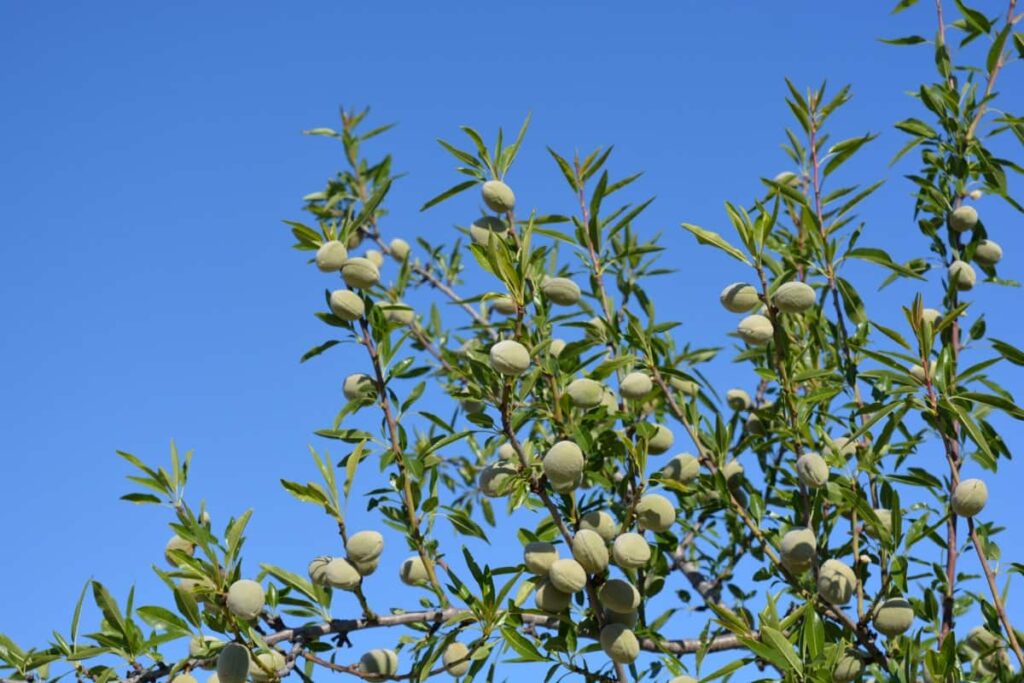
May Month Almond Orchard Maintenance Planning
In May, for almond orchard maintenance planning, it is recommended to perform summer plowing using an MB plow two to three times. This will help achieve a fine tilth and level the land. Proper alignment and peg marking should be done to guide pit digging. Opt for a spacing of 8×8 meters (64 plants/acre) or 7×7 meters (80 plants/acre).
When digging pits, separate the top 1.5 feet of soil to the right side and the bottom 1.5 feet to the left side of the pit. Expose the pit to sunlight for at least two weeks before filling it to control soil-borne pests and diseases. Ensure pit sizes of 60×60 centimeters or 45x45x45 centimeters based on soil depth. Procure plant material from reliable nurseries, preferably government nurseries or those recommended by the Department of Horticulture.
June Month Almond Orchard Maintenance Planning
- If there are good soaking rains, apply a mixture of 225 grams of urea, 150 grams of single super phosphate, and 40 grams of MOP (Muriate of Potash) around 30 to 45 centimeters from the basins’ main trunk.
- Plow the interspaces and sow green manure crops like Sunn-hemp or Cow-pea.
- When filling the pits, mix top soil with 10 kilograms of Farm Yard Manure (FYM), 200 grams of Single Super Phosphate, 1-2 kilograms of Neem Cake, and 100 grams of 10% Follidol dust per pit. Fill the pits with soil at least 6 inches above the ground level to accommodate soil settling.
- Establish thorn fencing or use a thick-growing live fence to prevent cattle trespassing.
- Mark out trench-cutting areas and complete trench-cutting for drip irrigation installation. These practices contribute to the overall health and productivity of the almond orchard.
July Month Almond Orchard Maintenance Planning
- Avoid repeat losses by purchasing high-quality plant material from selected nurseries with CIG members and farmers.
- At least four months old with 10 to 15 completely formed leaves, the plant should be 6 inches above the soil in the plastic bag. The graft union should be excellent.
- Plant the seedlings and water them until they sprout.
- Water or drip the pits if rains are scarce. Level pit soil before planting.
- Carefully remove the polythene sheet from the graft union and plant the sapling in the center of the hole without disturbing the dirt around the roots. Plant the graft union 6″ above ground.
- Stake the plant with a stout black tar-dipped stick to deter termites.
- After planting, water the plant every 4-5 days for the first month, then every 8-10 days if no rain falls for two years. These methods grow almond trees.
August Month Almond Orchard Maintenance Planning
In August, protect new sapling growth by spraying Quinolphos or Endosulphon every 15-20 days. Control weeds through monthly orchard weeding and shaping basins to retain water. Keep inter-spaces weed-free by plowing with a blade harrow or cultivator. Mulch basins with paddy husk, straw, or groundnut shells prevent evapotranspiration and weed growth. Remove rootstock side shoots. Prevent leaf spot diseases by spraying Copper Oxy Chloride during heavy rains. Early action prevents twig drying and plant death.
September Month Almond Orchard Maintenance Planning
In September, protect support sticks from termite attacks by spraying Chloropyriphos (Termex-C) at 5 ml/liter of water. Drench the basins with the same chemical. Prune side branches at ground level.
In case you missed it: Optimizing Fig/Anjeer Orchard Management: A Month-by-Month Operation Guide for Maximum Yield
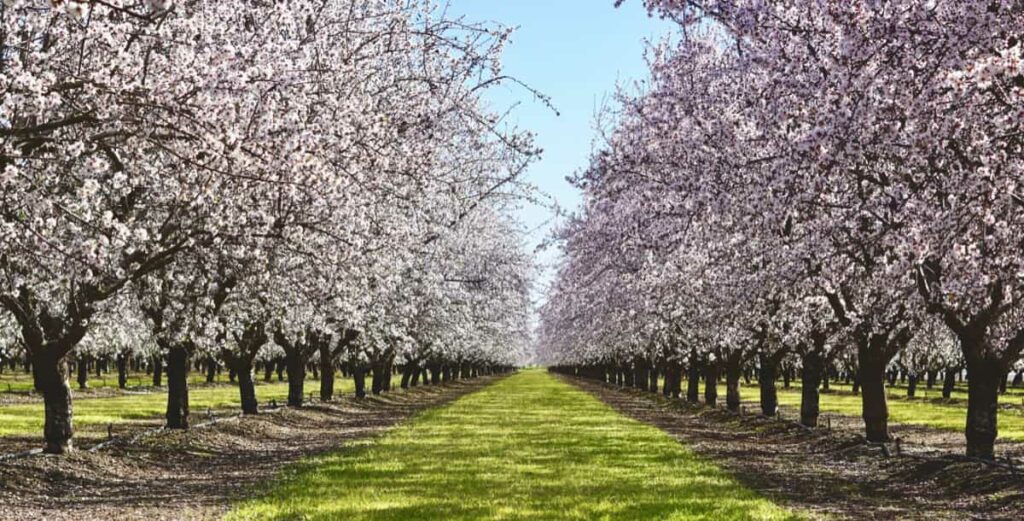
October Month Almond Orchard Maintenance Planning
In October, replanting any gaps in the orchard caused by plant deaths. Remove any side shoots on the rootstock. Planting can be done in areas with high rainfall from October to November. Farmers could sow intercrops for the rabi season this month if no intercrops were cultivated during June-July.
November Month Almond Orchard Maintenance Planning
In November, perform soil work in the basins of almond orchards and apply mulch with dry leaves or paddy straw to control evapotranspiration losses and weed growth. Additionally, remove any side shoots that emerge on the rootstock to promote the healthy growth of the main plant.
December Month Almond Orchard Maintenance Planning
In December, it is important to remove flower buds (by pinching) that appear along with new shoots on grafted almond plants to avoid hindering their growth. Additionally, watch out for pests like leaf webbers, thrips, and tea-mosquito that may attack the growing shoots from December to March. Control these pests by spraying monocrotopus (1.6 ml) or prophenophos (1.0 ml) per liter of water.
Conclusion
By following this month-by-month almond orchard management maintenance guide, including soil suitability assessment, irrigation, pest control, pruning, mulching, and proper care throughout the year, almond growers can optimize their yield and ensure healthy and productive almond trees for maximum output.
- Management Pests and Diseases in Your Cotton Field
- Sheep Farming Business Plan for Beginners
- Aquaponic Farming at Home: A Step-By-Step Guide
- Profitable Village Farming Business Ideas in 2024
- High-Yield Aquaculture: Fast-Growing Fish for Farming
- Effective Fish Pond Construction Techniques for Beginners
- Irrigation and Water Management in Pineapple Farming
- Blossom to Harvest: Mastering Flowering and Pollination in Papaya Farming
- Pig Fattening Essentials: From Selection to Sale for Beginners
- Raising Wagyu Cattle: A Complete Guide for Premium Beef Production
- Soil Types and Their Water Holding Capacity
- Optimizing Irrigation Schedules for Coconut Groves for Enhanced Yield
- Espresso Your Garden: Coffee Grounds for Healthier Acid-Loving Plants
- The Best Soil Mix for Snake Plants: How to Mix Your Own Snake Plant Soil
- Green Thumb Success: Expert Tips for Cultivating Greenhouse Beans All Year Round
- Bloom All Year Round: The Ultimate Guide to Indoor Hyacinth Care
- Eco-Friendly Gardening: How to Make Liquid Fertilizer from Kitchen Waste
- Ultimate Guide to Grow Anise in Pots: Explore Seed Propagation to Harvesting
- Guide to Raising Chester White Pigs: Discover Breed Facts to Growth Management
- Mastering the Elegance: The Ultimate Guide to Weeping Cherry Tree Care, Planting, and Maintenance
- Ultimate Guide to Planting Garlic in Grow Bags: Growing Strategies for Beginners
- How to Fix Spider Plant Leaf-Related Problems: Natural and Organic Remedies
- 10 Reasons Why Your Tulsi Plant is Shedding Leaves: Home Remedies and Solutions
- Optimizing Growth and Yield: The Advantages of Palm Bunch Ash Fertilizer
- Utilizing Neem Oil Extract as a Natural Pesticide for Hydrangea
- From Soil to Harvest: Various Ways in Which Farmers Can Use AI Tools
- Steps to Encourage and Induce Citrus Flowers: A Comprehensive Guide
- How to Fix Snake Plant Leaf-Related Issues: Natural and Organic Remedies
- Transform Your Garden into a Fragrant Oasis with Raat Ki Rani (Night Blooming Jasmine)
- Discover the Ideal Chicken Breeds for Philippine Farms
- How to Create a Poultry Egg Farm Business Plan for Profits
- Grow Lemon Cucumbers Like a Pro: Insider Techniques for Bountiful Yields
- Ultimate Guide to Caring for Your Pink Princess Philodendron: Tips for Thriving Variegation
- Areca Nut Profit Per Acre: Calculating Yield and Cost of Cultivation
- How Kaveri Chicken is Becoming a More Profitable Breed in Indian Backyards
- Transform Your Barn: 9 Steps to Convert a Horse Stall into a Chicken Coop
